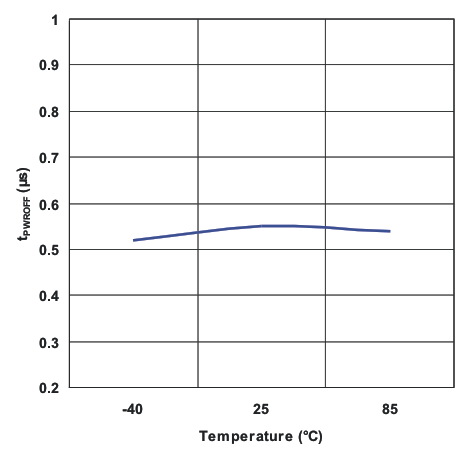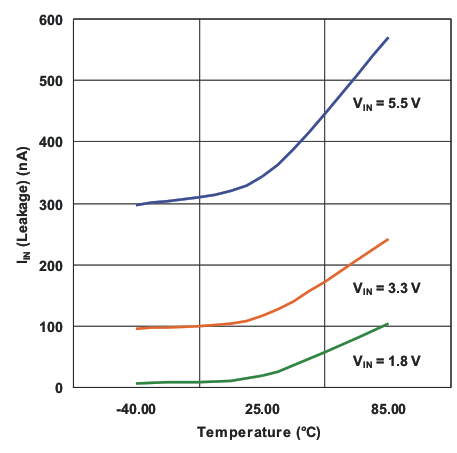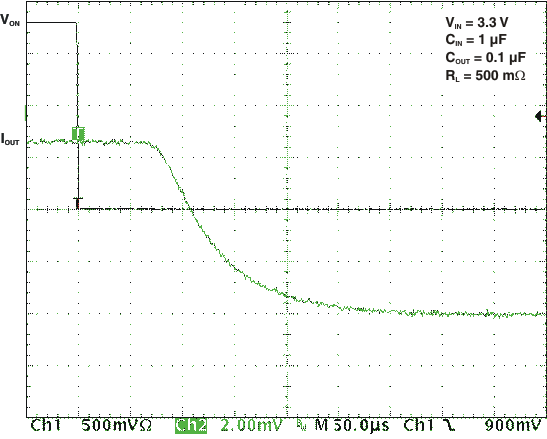SLVS984B September 2009 – March 2015 TPS22946
PRODUCTION DATA.
- 1 Features
- 2 Applications
- 3 Description
- 4 Revision History
- 5 Pin Configuration and Functions
- 6 Specifications
- 7 Parameter Measurement Information
- 8 Detailed Description
- 9 Application and Implementation
- 10Power Supply Recommendations
- 11Layout
- 12Device and Documentation Support
- 13Mechanical, Packaging, and Orderable Information
6 Specifications
6.1 Absolute Maximum Ratings
over operating free-air temperature range (unless otherwise noted)| MIN | MAX | UNIT | |||
|---|---|---|---|---|---|
| VI | Input voltage | VIN, VOUT, ON, CL | –0.3 | 6 | V |
| TJ | Operating junction temperature | –40 | 125 | °C | |
| Tstg | Storage temperature | –65 | 150 | °C | |
6.2 ESD Ratings
| VALUE | UNIT | |||
|---|---|---|---|---|
| V(ESD) | Electrostatic discharge | Human body model (HBM), per JEDEC specification JESD22 (A114-B, Class II)(1) | ±6000 | V |
| Charged-device model (CDM), per JEDEC specification JESD22-C101(2) | ±2000 | |||
(1) JEDEC document JEP155 states that 500-V HBM allows safe manufacturing with a standard ESD control process.
(2) JEDEC document JEP157 states that 250-V CDM allows safe manufacturing with a standard ESD control process.
6.3 Recommended Operating Conditions
over operating free-air temperature range (unless otherwise noted)| MIN | MAX | UNIT | |||
|---|---|---|---|---|---|
| VIN | Input voltage | 1.62 | 5.5 | V | |
| VON | ON pin voltage | 0 | 5.5 | V | |
| VCL | CL pin voltage | 0 | VIN | V | |
| VOUT | OUT pin voltage | 0 | VIN | V | |
| TA | Ambient free-air temperature | –40 | 85 | °C | |
| tCLSET | CL pin setting time | 8 | ms | ||
| CIN | Input capacitor | 1(1) | μF | ||
| VIH | ON high-level input voltage | VIN = 1.8 V | 1.1 | 5.5 | V |
| VIN = 2.5 V | 1.2 | 5.5 | |||
| VIN = 3.3 V | 1.3 | 5.5 | |||
| VIN = 5.5 V | 1.4 | 5.5 | |||
| VIL | ON low-level input voltage | VIN = 1.8 V | 0.4 | V | |
| VIN = 2.5 V | 0.4 | ||||
| VIN = 3.3 V | 0.5 | ||||
| VIN = 5.5 V | 0.6 | ||||
| VIH | CL low-level input voltage | VIN = 1.62 V to 5.5 V, IIH = 55 μA | 0.7 VIN | VIN | V |
| VIL | CL high-level input voltage | VIN = 1.62 V to 5.5 V, IIL = 55 μA | GND | 0.3 VIN | V |
(1) See Application Information.
6.4 Thermal Information
| THERMAL METRIC(1) | TPS22946 | UNIT | |
|---|---|---|---|
| YZP (DSBGA) | |||
| 6 PINS | |||
| RθJA | Junction-to-ambient thermal resistance | 131 | °C/W |
| RθJC(top) | Junction-to-case (top) thermal resistance | 1.3 | |
| RθJB | Junction-to-board thermal resistance | 22.6 | |
| ψJT | Junction-to-top characterization parameter | 5.2 | |
| ψJB | Junction-to-board characterization parameter | 22.6 | |
(1) For more information about traditional and new thermal metrics, see the IC Package Thermal Metrics application report, SPRA953.
6.5 Electrical Characteristics
VIN = 1.62 V to 5.5 V, TYP values at TA = 25°C (unless otherwise noted)| PARAMETER | TEST CONDITIONS | TA(1) | MIN | TYP | MAX | UNIT | ||
|---|---|---|---|---|---|---|---|---|
| IIN | Average quiescent current | IOUT = 0 mA, VIN = 4.5 V to 5.5 V | Full range | 1.5 | 5 | μA | ||
| IOUT = 0 mA, VIN = 3.0 V to 3.6 V | 1.3 | 4 | ||||||
| IOUT = 0 mA, VIN = 1.62 V to 1.98 V | 1 | 3 | ||||||
| IIN(OFF) | OFF state supply current | VON = 0 V | VIN = 3.6 V, VOUT open | Full range | 0.1 | 1 | μA | |
| IOUT(LEAKAGE) | OFF state switch current | VON = 0 V | VIN = 3.6 V, VOUT short to GND |
Full range | 0.1 | 1.1 | μA | |
| rON | ON-state resistance | IOUT = –100 mA | VIN = 5.5 V | 25°C | 0.3 | 0.4 | Ω | |
| Full range | 0.45 | |||||||
| VIN = 3.3 V | 25°C | 0.4 | 0.5 | |||||
| Full range | 0.55 | |||||||
| VIN = 2.5 V | 25°C | 0.5 | 0.6 | |||||
| Full range | 0.65 | |||||||
| VIN = 1.8 V | 25°C | 0.6 | 0.8 | |||||
| Full range | 0.85 | |||||||
| VIN = 1.62 V | 25°C | 0.7 | 0.9 | |||||
| Full range | 1 | |||||||
| ION | ON input leakage current | VON = VIN or GND | Full range | 1 | μA | |||
| ILIM | Current limit | VIN = 1.8 V, VOUT = 1.5 V, CL = GND | Full range | 70 | 85 | 120 | mA | |
| VIN = 3.3 V, VOUT = 3.0 V, CL = GND | Full range | 60 | 80 | 115 | ||||
| VIN = 1.8 V, VOUT = 1.5 V, CL = VIN | Full range | 155 | 175 | 235 | ||||
| VIN = 3.3 V, VOUT = 3.0 V, CL = VIN | Full range | 135 | 165 | 230 | ||||
| VIN = 1.8 V, VOUT = 1.5 V, CL floating | Full range | 30 | 45 | 60 | ||||
| VIN = 3.3 V, VOUT = 3.0 V, CL floating | Full range | 28 | 40 | 60 | ||||
| Ilimit_inrush | Inrush current limit | Rl = 1 Ω, VIN = 3.3 V, VOUT = 2.3 V | Full range | 375 | 435 | 685 | mA | |
| Thermal shutdown(2) | Shutdown threshold | Full range | 135 | °C | ||||
| Return from shutdown | 125 | |||||||
| Hysteresis | 10 | |||||||
| VOL | OC output logic low voltage | VIN = 5 V, ISINK = 10 mA | Full range | 0.1 | 0.2 | V | ||
| VIN = 1.8 V, ISINK = 10 mA | 0.1 | 0.3 | ||||||
| IOH | OC output high leakage current | VIN = 5 V, Switch ON | Full range | 1 | μA | |||
(1) Full range TA = –40°C to 85°C
(2) See Overtemperature Protection.
6.6 Switching Characteristics
VIN = 1.8 V, RL = 50 Ω, CL = 1 μF, TA = –40°C to 85°C, TYP values at TA = 25°C (unless otherwise noted)| PARAMETER | TEST CONDITIONS | MIN | TYP | MAX | UNIT | |
|---|---|---|---|---|---|---|
| tPWRON | Power-on time | RL = 50 Ω, CL = 1 μF | 192 | μs | ||
| tPWROFF | Power-off time | RL = 50 Ω, CL = 1 μF | 0.55 | μs | ||
| tON | Turnon time | RL = 50 Ω, CL = 1 μF | 125 | μs | ||
| tOFF | Turnoff time | RL = 50 Ω, CL = 1 μF | 115 | μs | ||
| tR | VOUT rise time | RL = 50 Ω, CL = 1 μF | 35 | μs | ||
| tF | VOUT fall time | RL = 50 Ω, CL = 1 μF | 120 | μs | ||
| tBLANK | Overcurrent blanking time | 7 | 10 | 15 | ms | |
| tRSTART | Auto-restart time | 50 | 70 | 95 | ms | |
| tTIMEOUT | Overcurrent detection time-out(3) | VIN = VON = 3.3 V, hard short(2) | 6000 | ms | ||
| tOVRTMP | Overtemperature detection maximum response time | 7.7 | ms | |||
| tMODOC | Moderate overcurrent detection maximum response time | VIN = VON = 1.8 V, Moderate over-current condition(1) | 63.5 | ms | ||
| VIN = VON = 3.3 V, Moderate overcurrent condition(1) | 65.5 | |||||
| tHARDSHORT | Hard-short detection maximum response time | VIN = VON = 1.8 V, hard short(2) | 270 | μs | ||
| VIN = VON = 3.3 V, hard short(2) | 295 | |||||
(1) If the current going through the switch is above ILIM, then the moderate over-current condition is activated
(2) Hard short check is performed at the output voltage of the switch. Hard short condition is active when VOUT < 2/3 VIN.
6.7 Typical Characteristics
 Figure 1. ON-Resistance vs Input Voltage
Figure 1. ON-Resistance vs Input Voltage
 Figure 3. Input Current (Quiescent) vs Temperature
Figure 3. Input Current (Quiescent) vs Temperature
 Figure 5. Input Current (Off) vs Temperature
Figure 5. Input Current (Off) vs Temperature
 Figure 7. Current Limit vs Input Voltage
Figure 7. Current Limit vs Input Voltage
 Figure 9. tReset vs Temperature
Figure 9. tReset vs Temperature
 Figure 11. tPWROFF vs Temperature
Figure 11. tPWROFF vs Temperature
 Figure 13. tON Response
Figure 13. tON Response
 Figure 15. tBlank Response
Figure 15. tBlank Response
 Figure 17. Hard Short-Circuit Response
Figure 17. Hard Short-Circuit Response
 Figure 19. Moderate Overcurrent Response
Figure 19. Moderate Overcurrent Response
 Figure 2. ON-Resistance Vs Temperature
Figure 2. ON-Resistance Vs Temperature
 Figure 4. Input Current (Leakage) vs Temperature
Figure 4. Input Current (Leakage) vs Temperature
 Figure 6. Current Limit vs Temperature
Figure 6. Current Limit vs Temperature
 Figure 8. tBlank vs Temperature
Figure 8. tBlank vs Temperature
 Figure 10. tPWRON vs Temperature
Figure 10. tPWRON vs Temperature
 Figure 12. ON Threshold
Figure 12. ON Threshold
 Figure 14. tOFF Response
Figure 14. tOFF Response
 Figure 16. tRestart Response
Figure 16. tRestart Response
 Figure 18. Short-Circuit Response
Figure 18. Short-Circuit Response